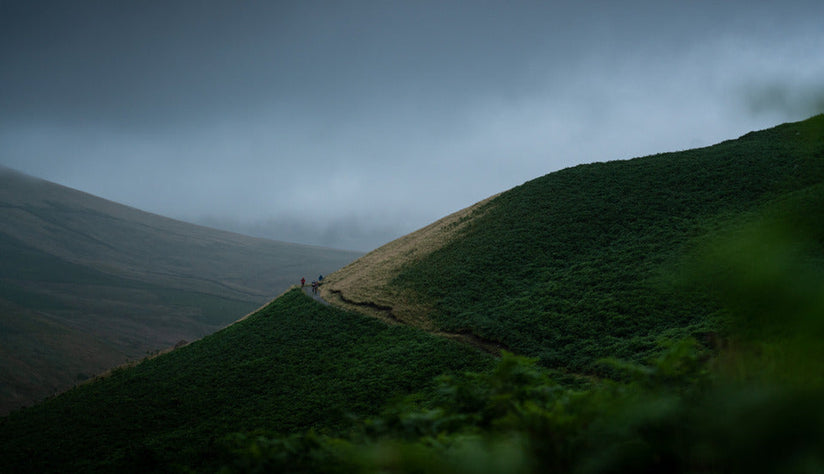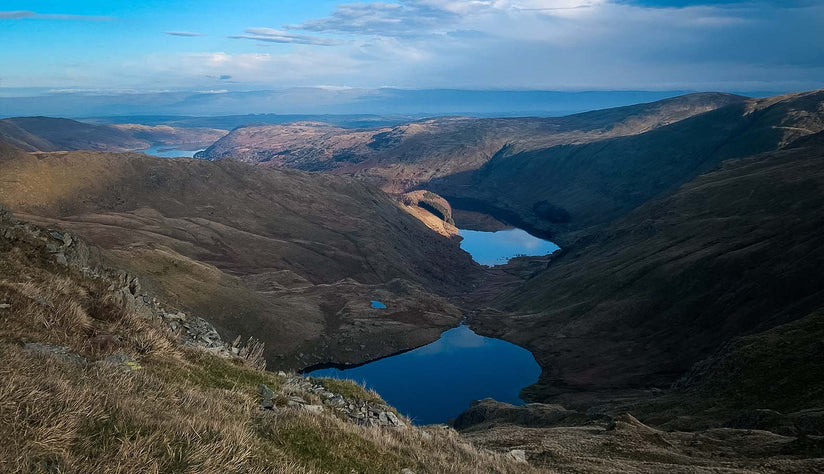We know plans can change in the mountains, just as the weather can. The good news is our new season gear has adaptability built in, so you’ll be prepared, no matter whatever you encounter this autumn. But ensuring you have the right technical kit to shelter you from challenging conditions is just the start…
Planning and preparing for the conditions you’ll likely face is also an important and responsible part of heading out into the great outdoors. But where do you begin? Intrepid adventurer Alice Morrison shares her advice for understanding the weather, including essential tools and things to watch out for.
Safety in the mountains
Last year, mountain rescue in England and Wales were called out to 3,629 emergencies and 21 people died walking and climbing in Scotland’s mountains. These are grim statistics and perhaps surprising given that our mountains are – relatively - not that high. The weather is changeable, though, with fog, high winds and heavy rain and snow sweeping in. Understanding the weather, wearing the right kit and preparing properly can help minimise the risks.
I am an adventurer and have walked across whole countries including Morocco and the Sahara and Jordan. I’ve also cycled from Cairo to Cape Town. Apart from tiredness and the mental stress of trying to complete expeditions and maintain team spirit, the hardest thing I have had to face is weather. For crossing the Sahara, it had to be done in winter as summer is just too hot both for me and the camels I was using as baggage transport. But even with that, there were weeks of heat and almost unbearable winds.
At the other extreme, I always try to climb Ben Nevis on boxing day with my cousin. Before we go, we check the weather, avalanche warnings, wind speed, the Nevis webcam and change our days if necessary. Even so, we have had to turn back when conditions have worsened to the point of danger. One time, snow started falling heavily before the summit and the winds picked up. We decided to abandon. It was a good decision. It took six hours to get down and on that descent, I was blown completely off my feet by the force of the gale and pushed towards the edge of the ridge.

Why is mountain weather so radical?
Everything in the mountains is intensified and nothing more so than the weather. We asked Dan the Weatherman DanielCorbettWeather.com, or Global Broadcast Meteorologist, to give him his correct title, why?
“Mountain weather is so unique because the forces of nature get amplified in mountain terrains. Everyone knows warm air rises but in a mountain setting, that means the warming daytime parcels of air move up the slopes of the mountain (Anabatic wind). This can, in turn, create greater uplift on the slopes, compared to the flat of a valley. The opposite happens at night, cold air slides down the mountain slope (Katabatic wind).
Add to this some moisture in the clouds and with the right conditions of warming, which is known as orographic enhancement, rainfall (and snowfall) can be much heavier and more intense than in a valley. The unique mountain terrain which enhances the weather can also make the mountain setting far more unpredictable. For example; fast weather changes are more likely to happen (good to bad) far more quickly than in other areas.” Dan, Global Broadcast Meteorologist

Planning for a hike
Navigation, weather knowledge and proper kit are your three best friends in hiking and especially in the mountains. Don’t assume that you will have mobile coverage, or that your phone won’t freeze/overheat and switch off. Your Apps are not enough. You need a map and compass and to be able to use them before you start off.
Here we are going to look at how you can educate yourself about the weather and also give you some top ideas on kit. Dave Rutledge, Training Officer from Cairngorms Mountain Rescue, told the Met Office his best advice for planning.
“The first thing is not to just look at it as a day out. The preparation and lead in time is vital too. Certainly in Scottish winter, what’s happened in the previous few days is as important as what’s going to happen on that day.
So, which way has the wind been blowing and has it brought in fresh snow? What were the conditions before that, so what is that fresh snow lying on? All of these are things that people should be thinking about before they head out.” Dave, Cairngorms Mountain Rescue Training Officer

Weather Tools
The great news for explorers today is that we now have a large array of really excellent tools available to us for predicting weather. If you are planning a hike or a long run in the mountains, start looking at patterns of current weather and future forecasts in advance. Things do change from day to day (sometimes hour to hour) but the past does also helps project into the future.
Good preparation is to look at your planned location as exactly as possible, but also to broaden that out, so that you can see what weather is coming in and how it might affect you. An excellent first point of call is the Met Office’s Mountain Forecast and the Mountain Weather Information Service. These cover 10 mountainous areas in the UK and also have specific peak information. This, of course, is vital because as we all know, the weather in the car park can be very different from the weather on the summit. This is where most inexperienced walkers come a cropper.
Two other sites that are also very useful as comparators are Meteor Radar, which predicts rainfall three hours ahead and Wind Finder, which can suck you into a world of nerdiness with its fabulous wind maps and super forecasters. Webcams for individual peaks are also addictive and very useful. Here is the Lake District to get you hooked.

Avalanche information
The biggest single killer of people in the mountains is avalanches. Even the most experienced and best-prepared climbers can be taken tragically, as you will know if you have seen, ‘The Alpinist.’ It is an absolute necessity to check out avalanche warnings. These are available on the Mountain Weather Information Service (MWIS) and the Scottish Avalanche Information Service is dedicated to risks in the five main mountainous areas.
Understanding weather
You may not be able to become a BBC weather presenter overnight, but it is useful to understand some of the basic building blocks of our weather systems.
1. Atmospheric Pressure
Atmospheric, or barometric pressure, measures the force caused by the weight of the air above you. Low pressure means the air is moving upwards and the weather may change, whilst high pressure means the air is heavy and is staying the same above land level, and the weather should be stable. So, if the forecast shows a low front coming in, you can predict unpredictability.
2. Wind
Wind patterns in a region tend to be regular – west to southwesterly are the prevailing winds in the UK. To take you back to my walking the Sahara example. For over 8 weeks the wind blew daily into my left ear and we navigated using it and the sun. I also got a nasty ear infection and some mental scarring. If the wind changes direction from its ‘usual’ course, be alert to weather changes and storm possibilities.
3. Clouds
Most of us use big, black clouds to tell us when rain is coming, but there is a whole range of different types of formations that can be useful. Look at the types of cloud, their altitude, and the cloud layers. Starting from the top: Cirrus clouds are high and wispy and don’t affect ground level too much, but can be predictors if there are lots of them. Stratus are in the middle and are varied but when they start clumping together and darkening, they herald rain. Cumulus are the white fluffy clouds that you used to draw at primary school. However, these can build and darken and become thunderheads which then bring heavy rain and storms.

Wearing and carrying the right kit
The importance of the right clothes and equipment for safe hiking and mountaineering cannot be stressed enough. Invest in yourself and your security and comfort. For any hill walking whether it be winter or summer, you will need:
-
Proper layers
-
Waterproofs
-
A warm insulated down jacket
-
First Aid kit including whistle, mirror, and foil blanket
-
Walking poles
-
A water hydration system and adequate water
-
High energy snacks
-
Cap and buff
-
Map and compass
In winter and with snowy conditions add:
-
Crampons
-
Ice axe
-
Hat and gloves
-
Extra layers
-
Waterproof bag inside backpack to keep some kit dry
Even if it seems like overkill and you want to keep your backpack light, pack some warm and waterproof layers. You cannot predict what will happen on the hill. The stress of walking on your body can mean you heat up and cool down much more quickly than normal. If you have layers to take on and off, you can help regulate your temperature and power output.
Knowledge is power (and fun)
Nothing is more fun than a great day or days out in the mountains. Preparing for your adventure and making sure you are keeping yourself and your companions safe and happy is part of that. Understanding the weather and planning for it is a key component. It is also really enjoyable to start learning more about how our planet works – yes I am addicted to wind patterns.
3 tips for safe walking
1. Use all these tools to understand the weather and plan. If the weather is bad or there is an avalanche risk, change your dates. Live to walk another day.
2. Have a backup plan for a different exit route or a way to abandon it if it is getting hairy.
3. Wear and pack the right kit and always pack waterproofs and good layers. Walking poles are a fantastic safety net.
This article was brought to you by experienced adventurer Alice Morrison. You can hear more from Alice, including about her expedition in the Sahara Desert, in our official podcast.
















